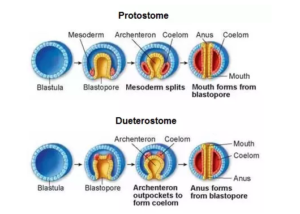


The same genes play critical roles throughout the animal kingdom, small changes in how they are activated leading to very different body forms. The body plans of all animals are assembled along a similar path, as if from the same basic blueprint. Perhaps the most important lesson to emerge from the study of animal diversity is not the incredible variety of animal forms, from worms and spiders to sharks and antelopes, but rather their deep similarities. In deuterostomes, the egg cleaves radially, and the blastopore becomes the animal's anus. In protostomes, the egg cleaves spirally, and the blastopore becomes the mouth.

The evaginating cells give rise to the mesodermal cells, and the mesoderm expands to form the coelom. This cavity, lined with endoderm, opens to the outside via the blastopore and eventually becomes the gut cavity. However, in deuterostomes, the coelom is normally produced by an evagination of the archenteron-the main cavity within the gastrula, also called the primitive gut. In protostomes, this occurs simply and directly: The mesoderm cells simply move away from one another as the coelomic cavity expands within the mesoderm. In all coelomates, the coelom originates from mesoderm. In deuterostomes, on the other hand, the first cleavage divisions of the fertilized embryo produce identical daughter cells, and any single cell, if separated, can develop into a complete organism.ģ. Even at the four-celled stage, each cell is different, containing different chemical developmental signals and no one cell, if separated from the others, can develop into a complete animal. In protostomes, the developmental fate of each cell in the embryo is fixed when that cell first appears. This pattern is called radial cleavage because a line drawn through a sequence of dividing cells describes a radius outward from the polar axis (indicated by the straight blue arrow at the 32-cell stage).Ģ. As a result, the pairs of cells from each division are positioned directly above and below one another (see the 16-cell stage in the lower row of cells) this process gives rise to a loosely packed array of cells. In deuterostomes, the cells divide parallel to and at right angles to the polar axis. This pattern is called spiral cleavage because a line drawn through a sequence of dividing cells spirals outward from the polar axis, (indicated by the curving blue arrow at the 32-cell stage). As a result, a new cell nestles into the space between the older ones in a closely packed array (see the 16-cell stage in the upper row of cells).

In nearly all protostomes, each new cell buds off at an angle oblique to the polar axis. The cleavage pattern relative to the embryo’s polar axis determines how the cells array. The progressive division of cells during embryonic growth is called cleavage. In addition to the fate of the blastopore, deutero-stomes differ from protostomes in three other features:ġ. The coelom originates from an evagination, or outpouching, of the archenteron in deuterostomes.ĭeuterostomes represent a revolution in embryonic development. The blastopore becomes the animal's anus, and the mouth develops at the other end. In deuterostomes, embryonic cells cleave radially and form a loosely packed array. The blastopore becomes the animal's mouth, and the coelom originates from a mesodermal split. In protostomes, embryonic cells cleave in a spiral pattern and become tightly packed. Invagination, or infolding, of the blastula produces the blastopore. Embryonic development in protostomes and deuterostomes.Ĭleavage of the egg produces a hollow ball of cells called the blastula. This group of phyla consists of animals that are called the deuterostomes (figure 19.26, bottom).įigure 19.26. In these animals, the anus forms from or near the blastopore, and the mouth forms subsequently on another part of the blastula. If such an animal has a distinct anus or anal pore, it develops later in another region of the embryo.Ī second distinct pattern of embryological development occurs in the echinoderms and the chordates. An animal whose mouth develops in this way is called a protostome (figure 19.26, top). In mollusks, annelids, and arthropods, the mouth (stoma) develops from or near the blastopore. Cell divisions of the fertilized egg produce a hollow ball of cells, a blastula, which indents to form a two-layer-thick ball with a blastopore opening to the outside. All the animals we have met so far have essentially the same kind of embryonic development.


 0 kommentar(er)
0 kommentar(er)
